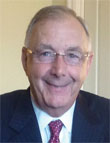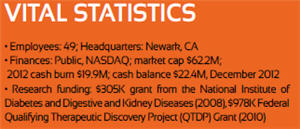Companies To Watch: StemCells
By Wayne Koberstein, Executive Editor, Life Science Leader
Follow Me On Twitter @WayneKoberstein
A cautious agenda in developing tissue-derived adult stem cell therapeutics could lead to big leaps in patients’ quality of life.
SNAPSHOT
StemCells supplies research materials and cell lines to laboratories, but its main purpose is to develop a pipeline of stem cell-based therapeutics for spinal cord injury, dry age-related macular degeneration (AMD), Pelizaeus-Merzbacher disease (PMD, a rare myelination disorder in the brain), and Alzheimer’s disease. Although the company supplies stem cell lines from all sources, including embryonic, its therapeutic pipeline uses only tissue-derived adult stem cells, which originate from the respective organ or tissue to be treated. Tissue-derived stem cells grow reliably into the type of cells from which they were taken, so in contrast to embryonic or induced pluripotent stem (iPS) cells, no “programming” is needed. The company’s stem cells are also allogeneic — derived from donors and requiring no modification — rather than autologous — derived from individual patients and potentially needing correction for damaged genes. Given such properties, StemCells asserts that its cells circumvent the high costs and technical roadblocks that have defeated commercialization of other stem cell therapeutics. In fact, the company touts its technology’s potential to make “stem cells in a bottle,” similar to other biotherapeutics or pharmaceuticals.
 LATEST UPDATES
LATEST UPDATES
- February 2013: Favorable 12-month data from the first patient cohort in StemCells’ Phase 1/2 clinical trial of its HuCNS-SC product (purified human neural stem cells) for chronic spinal cord injury (SCI) demonstrating two of three patients had multisegment gains in sensory function following transplantation of the cells. These were first observed at 6 months and persisted after 12 months.
- October 2012: 1) Publication in Science Translational Medicine of Phase 1 clinical data showing evidence of new myelination in PMD patients following transplantation of HuCNS-SC cells; patients also had modest gains in neurological function. 2) The first patient dosed in a Phase 1/2 clinical trial of HuCNS-SC cells in patients with dry age-related macular degeneration (AMD).
WHAT’S AT STAKE
The name StemCells reflects the company’s brave but cautious approach. Brave, because people have sometimes rated the prospects of stem cell technology somewhat equal to that of cold fusion. Cautious, because the company “has not taken a ‘bet the house’ approach to searching for new treatments for serious diseases.” StemCells also hired a seasoned CEO, Martin McGlynn, a self-described veteran of the pharma industry, who cut his executive teeth at Becton Dickinson, Abbott, and Anaquest before heading into the entrepreneurial life sciences world.
What does the favorable Phase 1/2 data for its HuCNS-SC neural stem cells in SCI really mean? Recently announced one-year results from its spinal-cord injury trial showed “considerable gains in sensory function observed in two of the three patients at the six-month assessment have persisted.” No one got up and walked away, like a miracle in an old-time revival — but the sensory-function gain is just what the company is aiming for among a number of defined clinical endpoints in its now-enrolling Phase 1/2 trial: changes in sensation, motor, and bowel/bladder function. This is a cautious approach, but justified based on data showing the ability of the HuCNS-SC cells to differentiate into the specialized neural cells which produce myelin, the sheathing around nerves.
The American Spinal Injury Association Impairment Scale (AIS) classifies SCI patients into groups A, B, and C, in descending order of severity in symptoms and extent of paralysis. To widen the patient base, StemCells convinced Swiss regulators to allow a three-tiered study design covering AIS A, B, and C patients. Any benefit in the AIS A group would be gravy, but a very rich one, as any treatment advances would be unexpected.
 StemCells’ development programs in other areas display similarly cautious approaches, and they all recognize the same principle: In severe conditions like SCI, no noticeable benefit is trivial — and some benefits, though far removed from a cure, can be profound. Perhaps if StemCells succeeds in such modest but significant aims, it will someday reach one of its longer-term goals: regenerating nerve cells to free patients from the chains we now accept as permanent.
StemCells’ development programs in other areas display similarly cautious approaches, and they all recognize the same principle: In severe conditions like SCI, no noticeable benefit is trivial — and some benefits, though far removed from a cure, can be profound. Perhaps if StemCells succeeds in such modest but significant aims, it will someday reach one of its longer-term goals: regenerating nerve cells to free patients from the chains we now accept as permanent.
